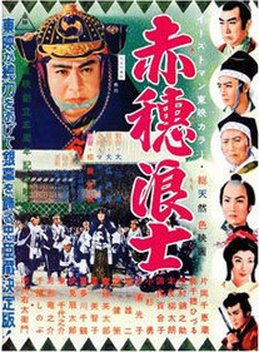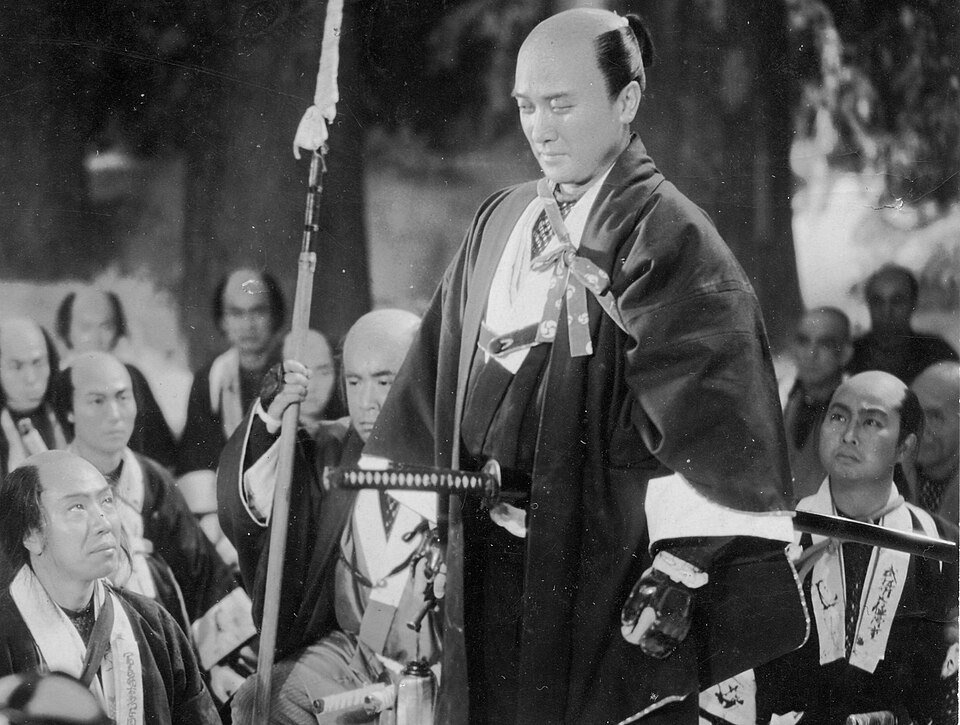
The 47 Ronin (V.O. Genroku Chûshingura)
Japan, 1941
Director: Kenji Mizoguchi
Screenplay:
Kenichiro Hara, Seika Mayama, Yoshikata Yoda
Cast:
Chôjûrô Kawarasaki, (Kuranosuke Ooishi), Kan’emon Nakamura (Sukeimon Tomimori), Kunitarô Kawarazaki (Jurôzaemon Isogai), Yoshizaburo Arashi (Takuminokami Asano), Chôemon Bandô (Sôemon Hara)
Plot
Japan, Tokugawa era, early 18th century. In the corridors of the shogun’s palace, an altercation takes place in which the high official Kira is wounded by a daimyo, the feudal lord Asano. The latter, tired of the outrages of the former, decided to attempt against Kira, but failed in his homicidal purpose. Once arrested, he says that he has nothing against the shogun, and that he regrets… not having killed Kira. By express order of the shogun, Asano is condemned to commit seppuku; and the 47 samurai who were in his service, headed by the chamberlain Oishi, become ronin, samurai without a lord. The Asano clan is dissolved. The “unemployed” samurai, moved by a loyalty to their lord that goes beyond death, decide to take revenge on Kira, and after many preparations cut off his head, after which they surrender to the authorities. The authorities grant them the honor of dying by seppuku instead of being executed as common criminals. Finally, one after another commits hara-kiri, until it is the turn of the leader of the ronin, Oishi.

Commentary
This colossal feature film, almost 4 hours long, was released in Japanese theaters in two phases: The first installment in December 1941, and the second in 1942. Specifically, the first part appeared on December 11, only four days after the Pearl Harbor incident.
The story is based on true events, and tells of a chivalric epic deeply rooted in Japan, where it has acquired the tints of legend, an epic deeply steeped in the Bushido, or samurai code of honor; one that emphasizes the virile qualities of courage, loyalty and sacrifice.
While the subject matter is fascinating, this film falters woefully because, in all likelihood, it has not aged well. First of all it is extremely long, very slow paced, and also negatively influenced by the fact that I had the misfortune of watching it with subtitles that were not well synchronized (this is especially the case in the first part).
Other later films, such as those of Sergio Leone, can also be considered “long and slow”, but nevertheless in these ones the dramatic tension is maintained at all times, thanks in part to the excellent soundtrack by Morricone.
Later, other adaptations of the story of the 47 Ronin would be made, the most recent, in 2013, by the USA and with the “gaijin” Keanu Reeves as the protagonist, playing a Japanese-British half-breed… Without having seen that film, it is not difficult to guess that Hollywood will not be very faithful to the original Japanese story (and to the characteristic Japanese style).
Regarding the Genroku of the forties, the second part (released in 1942) improves on the first (1941), due to the inclusion of scenes of Japanese culture such as the kabuki theater (even during the lifetime of the 47 ronin, they achieved a vast popularity due to the theatrical works made about them), traditional music (which contrasts with the soundtrack of the film itself, very “westernized” and not very different from those used for American productions at the same time), and the plot is evident in the final drama of the ritual suicide to which the brave samurai without owners are forced to commit. Thanks especially to the second part, those who watch the film can get an idea of what daily life was like at the court of feudal Japan in the Tokugawa era, its mentality and customs.
Mizoguchi’s “The 47 Ronin” will be interesting for cinephiles and Japanophiles, but it will bore and tire the vast public, those who only watch films “for entertainment”.
Get The 47 Ronin HERE!
(This is an affiliate link. I may earn a commission if you purchase through these link, at no extra cost to you. As an Amazon Associate, I earn from qualifying purchases.)

Pingback: Harakiri – Masaki Kobayashi, 1962 - Hara